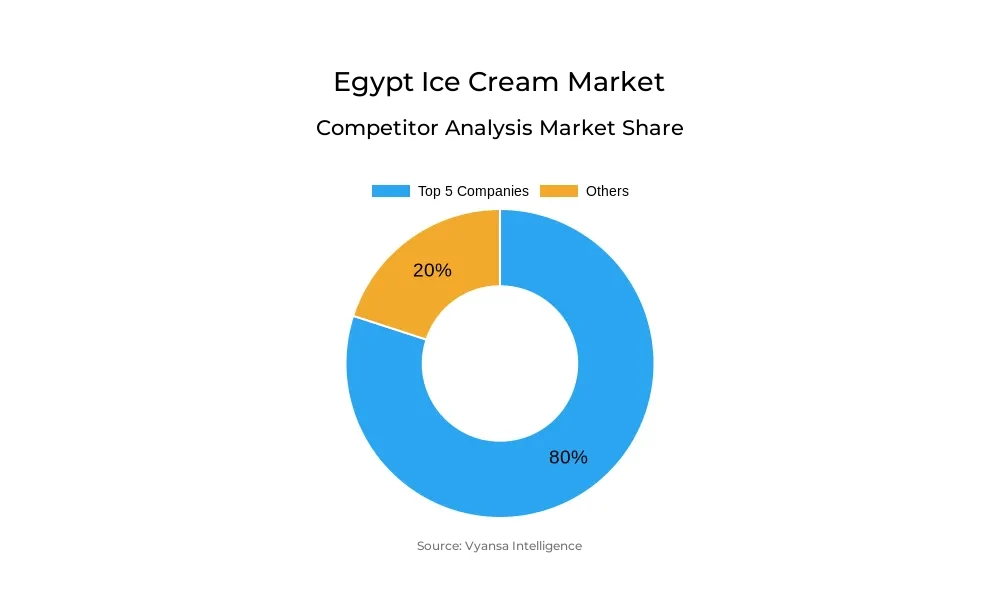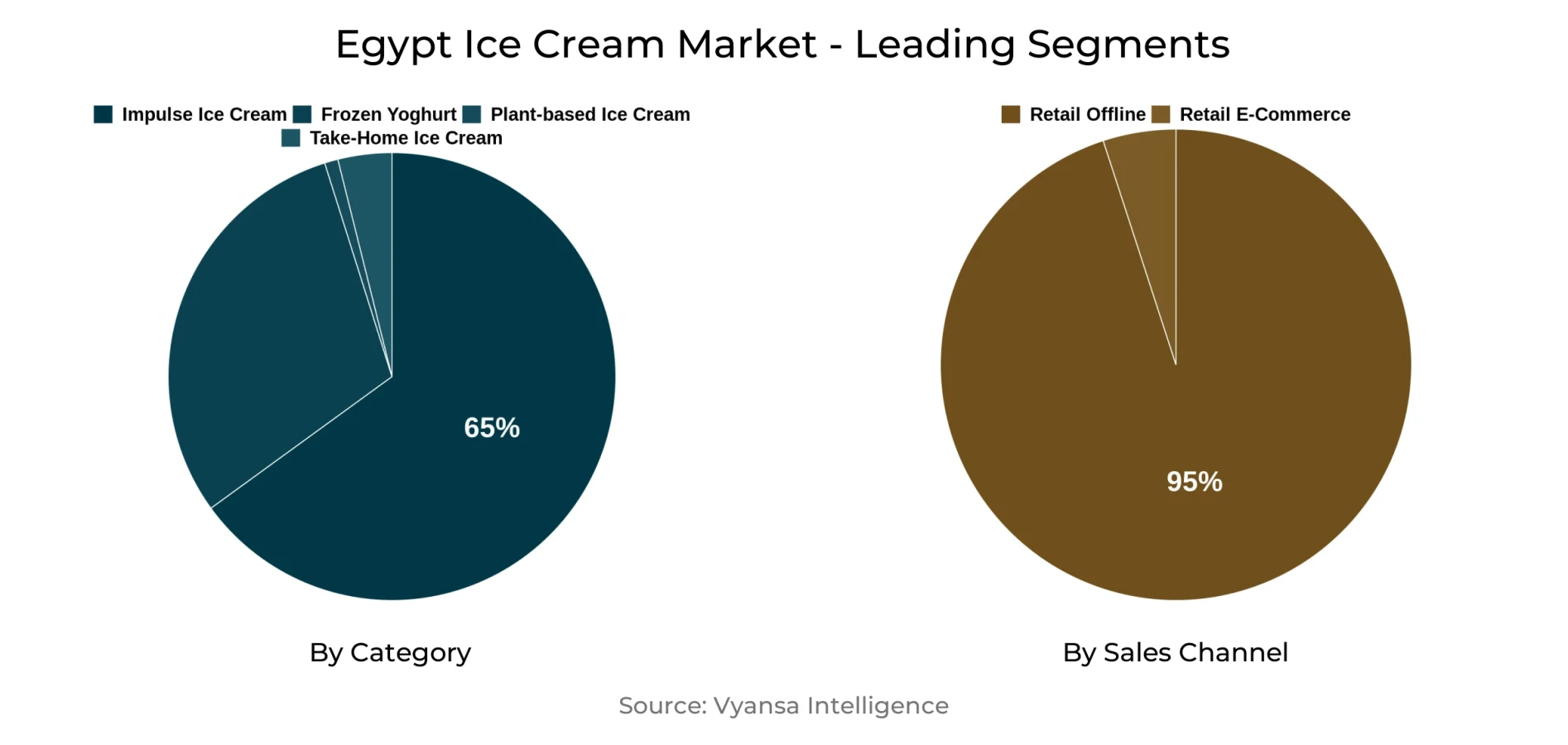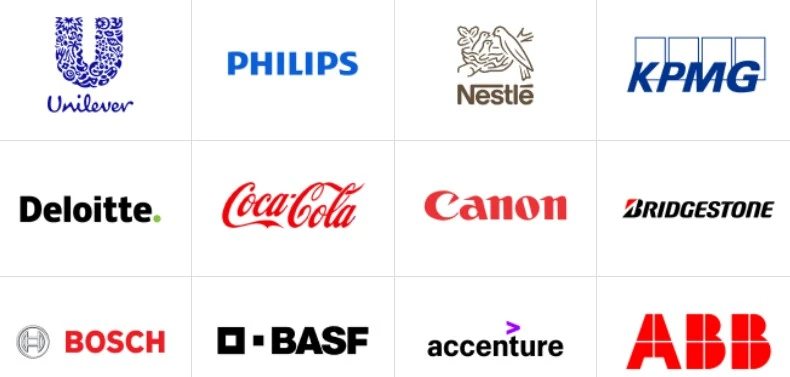Egypt Ice Cream Market Report: Trends, Growth and Forecast (2025-2030)
By Category (Frozen Yoghurt, Impulse Ice Cream, Plant-based Ice Cream, Take-Home Ice Cream), By Leading Flavours (Chocolate, Vanilla, Strawberry, Cookies & Cream, Caramel, Mango, Pralines & Cream, Kulfi), By Format (Cup, Stick, Cone, Brick), By Sales Channel (Retail Offline, Retail E-Commerce)
- Food & Beverage
- Dec 2025
- VI0002
- 123
-




Egypt Ice Cream Market Statistics and Insights, 2025
- Market Size Statistics
- Ice Cream in Egypt is estimated at $ 255 Million.
- The market size is expected to grow to $ 295 Million by 2030.
- Market to register a CAGR of around 2.46% during 2025-30.
- Product Shares Shares
- Impulse Ice Cream grabbed market share of 65%.
- Impulse Ice Cream to witness a volume CAGR of around 0.74%.
- Competition
- More than 10 companies are actively engaged in producing Ice Cream in Egypt.
- Top 5 companies acquired 80% of the market share.
- Master Foods Middle East FZE, IFFCO Group, Nestlé Egypt SAE, Froneri Ice Cream Egypt SAE, Hawaii for Industry & Trade etc., are few of the top companies.
- Sales Channel
- Retail Offline grabbed 95% of the market.
Egypt Ice Cream Market Outlook
Egypt's ice cream industry is projected to see steady growth in 2025 despite a current prevailing of economic challenges, including high inflation, devaluation of the local currency, and import limitations on major raw materials such as milk, stabilisers, and flavourings. Even though these have led to high price hikes, demand has been resilient due to the hot climate of the country, urbanisation, and a growing population.
Single-serve dairy ice cream remains a strong growth driver because it is affordable and impulse-led, drawing consumers even in the face of economic uncertainty. Local brands appealing to price-conscious consumers through value-for-money offerings and trend-driven flavours like caramelised biscuit and cotton candy are also driving market momentum.
Though new retail chains are expanding, local smaller grocers continue to be the main distribution outlet because they are close by and convenient. E-commerce, however, continues to fall behind because of cold chain constraints, but could expand with planned future investment in infrastructure. Unpackaged ice creams are becoming popular among high-income urban consumers, with stores catering to premium, vegan, and healthier alternatives like low-sugar and non-dairy versions. The segment is placed as a luxury treat, resonating with shifting consumer tastes.
Market leaders will keep its front position by driving innovation continuously, such as culturally relevant flavours like Basbousa and Om Ali ice creams introduced during Ramadan. Nevertheless, the local players will manage to capture market share based on stable pricing and effective sourcing methods. Generally, the market situation is optimistic as it is backed by consumption driven by indulgence and increasing demand for diverse, affordable, and innovative ice cream.

Egypt Ice Cream Market Growth Driver
Egypt's record 15.7 million tourist flow in 2024, breaking 2023's figure of 14.9 million, indicates a good recovery of the tourism industry. Egypt generated USD 14.1 billion in 2024 planning for a national strategy to reach an inflow of 30 million tourists by 2028. It indicates the increasing tourism and positioning Egypt as a source travel destination of the world, significantly enhancing the demand in different end users' markets such as food and beverages. The visitors predominantly during the peak season increased demand of cool and hedonic products such as ice creams. In addition, Egypt's hot climate serves a crucial purpose in the sale of the ice cream because the ultimate consumers require a cold dessert throughout the year. The Fast-growing Egyptian population and increasing urbanisation, whose combination has made Egyptians exposed to modern retailing channels and a wider range of ice creams.
Egypt Ice Cream Market Trend
The ongoing developing end users taste, heightened focus on healthier and local product innovations, for example, trend towards low-fat, lower-sugar and lower-calorie ice cream products. The manufacturers are also concentrating on adding more natural ingredients, for instance, fresh fruits to address the growing health awareness among the end consumers. Even in the wake of the shift, indulgence continues to be the key reason, particularly in the case of single-portion dairy-based products, which seem to have a better nutritional profile than water-based equivalents.
As well as that, market leaders such as Froneri are launching distinctive products which are prepared in the traditional Egyptian and Middle Eastern desserts, which bring in broader end user bases. It comprises Basbousa and Om Ali, particularly during culturally important events such as Ramadan. The blending of culturally relevant and health-oriented products is assisting brands in appealing to more end users, thus expanding the market share.
Egypt Ice Cream Market Opportunity
The demand for the unpackaged ice cream, especially among middle and high income end users is shortly going to rise. It is being driven by the aggresive growth of premium ice cream shops across the city centers, offering the end users a variety of innovative and unique flavors. The higher the prices of unpackaged goods, the more acceptable as luxuries. These goods are being utilized by the high-income end users and being transformed and upgraded in accordance with the market situation. Additionally, foodservice units duplicating the ice creams with healthier alternatives like vegan, non-dairy, and low-sugar ice creams targeting diet-specific and health-conscious end consumers. It is a choice that brands would want and mass merchants seeking high-value, specialty end consumers and health-conscious end consumers in Egypt's cosmopolitan urban living.
| Report Coverage | Details |
|---|---|
| Market Forecast | 2025-30 |
| USD Value 2024 | $ 255 Million |
| USD Value 2030 | $ 295 Million |
| CAGR 2025-2030 | 2.46% |
| Largest Category | Impulse Ice Cream segment leads with 65% market share |
| Top Drivers | Surge in Tourism and Urbanization Fueling Market Demand |
| Top Trends | Traction Towards Health-Conscious Indulgence with Cultural Fusion |
| Top Opportunities | Rising Preference for Premium and Health-Conscious Unpackaged Offerings |
| Key Players | Master Foods Middle East FZE, IFFCO Group, Nestlé Egypt SAE, Froneri Ice Cream Egypt SAE, Hawaii for Industry & Trade, AMR Ice Cream Co, Egyptian Italian Food Co, Ice Food Co for Food Industries, Tsepass Pastry Co, Swiss Premium Foods Egypt and Others. |
Egypt Ice Cream Market Segmentation Analysis

Single-serve dairy impulse ice cream is the category leader under the Category segment with market share of approximately 65%. Market demand is propelled by market leadership of single-serve dairy impulse ice cream. This is largely attributable to the relatively low price point, making it a suitable treat choice for a broad base of end users. Spontaneously purchased the majority of the time, the nature of product gains advantage due to impulse buying behavior when the end consumers are less price-conscious, thereby ensuring stability during economic downturns and price variations. Additionally, the arrival of local competition with low prices are aiming for the low-income consumers has also strengthened its market share by ensuring end user engagement. Also, the introduction of new variants like cotton candy and caramel biscuit is continuing to attract end user's attention and is emerging as a strong driver for its repeat purchase. All the conditions combined are propelling the ongoing growth and popularity of the single-portion dairy impulse ice cream category.
Top Companies in Egypt Ice Cream Market
The top companies operating in the market include Master Foods Middle East FZE, IFFCO Group, Nestlé Egypt SAE, Froneri Ice Cream Egypt SAE, Hawaii for Industry & Trade, AMR Ice Cream Co, Egyptian Italian Food Co, Ice Food Co for Food Industries, Tsepass Pastry Co, Swiss Premium Foods Egypt, etc., are the top players operating in the Egypt Ice Cream Market.
Frequently Asked Questions
Related Report
1. Market Segmentation
1.1. Research Scope
1.2. Research Methodology
1.3. Definitions and Assumptions
2. Executive Summary
3. Egypt Ice Cream Market Policies, Regulations, and Standards
4. Egypt Ice Cream Market Dynamics
4.1. Growth Factors
4.2. Challenges
4.3. Trends
4.4. Opportunities
5. Egypt Ice Cream Market Statistics, 2020-2030F
5.1. Market Size & Growth Outlook
5.1.1.By Revenues in US$ Million
5.1.2.By Volume in Million Litres
5.2. Market Segmentation & Growth Outlook
5.2.1.By Category
5.2.1.1. Frozen Yoghurt- Market Insights and Forecast, 2020-2030, USD Million
5.2.1.2. Impulse Ice Cream- Market Insights and Forecast, 2020-2030, USD Million
5.2.1.2.1. Single Portion Dairy Ice Cream- Market Insights and Forecast, 2020-2030, USD Million
5.2.1.2.2. Single Portion Water Ice Cream- Market Insights and Forecast, 2020-2030, USD Million
5.2.1.3. Plant-based Ice Cream- Market Insights and Forecast, 2020-2030, USD Million
5.2.1.4. Take-Home Ice Cream- Market Insights and Forecast, 2020-2030, USD Million
5.2.1.4.1. Take-Home Dairy Ice Cream- Market Insights and Forecast, 2020-2030, USD Million
5.2.1.4.1.1. Bulk Dairy Ice Cream- Market Insights and Forecast, 2020-2030, USD Million
5.2.1.4.1.2. Multi-Pack Dairy Ice Cream- Market Insights and Forecast, 2020-2030, USD Million
5.2.1.4.2. Take-Home Water Ice Cream- Market Insights and Forecast, 2020-2030, USD Million
5.2.1.4.2.1. Bulk Water Ice Cream- Market Insights and Forecast, 2020-2030, USD Million
5.2.1.4.2.2. Multi-Pack Water Ice Cream- Market Insights and Forecast, 2020-2030, USD Million
5.2.2.By Leading Flavours
5.2.2.1. Chocolate- Market Insights and Forecast, 2020-2030, USD Million
5.2.2.2. Vanilla- Market Insights and Forecast, 2020-2030, USD Million
5.2.2.3. Strawberry- Market Insights and Forecast, 2020-2030, USD Million
5.2.2.4. Cookies & Cream- Market Insights and Forecast, 2020-2030, USD Million
5.2.2.5. Caramel- Market Insights and Forecast, 2020-2030, USD Million
5.2.2.6. Mango- Market Insights and Forecast, 2020-2030, USD Million
5.2.2.7. Pralines & Cream- Market Insights and Forecast, 2020-2030, USD Million
5.2.2.8. Kulfi- Market Insights and Forecast, 2020-2030, USD Million
5.2.3.By Format
5.2.3.1. Cup- Market Insights and Forecast, 2020-2030, USD Million
5.2.3.2. Stick- Market Insights and Forecast, 2020-2030, USD Million
5.2.3.3. Cone- Market Insights and Forecast, 2020-2030, USD Million
5.2.3.4. Brick- Market Insights and Forecast, 2020-2030, USD Million
5.2.3.5. Others (Sandwich, Tub, etc.)- Market Insights and Forecast, 2020-2030, USD Million
5.2.4.By Sales Channel
5.2.4.1. Retail Offline- Market Insights and Forecast, 2020-2030, USD Million
5.2.4.1.1. Grocery Retailers- Market Insights and Forecast, 2020-2030, USD Million
5.2.4.1.1.1. Convenience Retailers- Market Insights and Forecast, 2020-2030, USD Million
5.2.4.1.1.1.1. Convenience Stores- Market Insights and Forecast, 2020-2030, USD Million
5.2.4.1.1.1.2. Forecourt Retailers- Market Insights and Forecast, 2020-2030, USD Million
5.2.4.1.1.2. Supermarkets- Market Insights and Forecast, 2020-2030, USD Million
5.2.4.1.1.3. Hypermarkets- Market Insights and Forecast, 2020-2030, USD Million
5.2.4.1.1.4. Food & Drink Specialists- Market Insights and Forecast, 2020-2030, USD Million
5.2.4.1.1.5. Small Local Grocers- Market Insights and Forecast, 2020-2030, USD Million
5.2.4.2. Retail E-Commerce- Market Insights and Forecast, 2020-2030, USD Million
5.2.5.By Competitors
5.2.5.1. Competition Characteristics
5.2.5.2. Market Share & Analysis
6. Egypt Frozen Yoghurt Ice Cream Market Statistics, 2020-2030F
6.1. Market Size & Growth Outlook
6.1.1.By Revenues in US$ Million
6.1.2.By Volume in Million Litres
6.2. Market Segmentation & Growth Outlook
6.2.1.By Leading Flavours- Market Insights and Forecast, 2020-2030, USD Million
6.2.2.By Format- Market Insights and Forecast, 2020-2030, USD Million
6.2.3.By Sales Channel- Market Insights and Forecast, 2020-2030, USD Million
7. Egypt Impulse Ice Cream Market Statistics, 2020-2030F
7.1. Market Size & Growth Outlook
7.1.1.By Revenues in US$ Million
7.1.2.By Volume in Million Litres
7.2. Market Segmentation & Growth Outlook
7.2.1.By Leading Flavours- Market Insights and Forecast, 2020-2030, USD Million
7.2.2.By Format- Market Insights and Forecast, 2020-2030, USD Million
7.2.3.By Sales Channel- Market Insights and Forecast, 2020-2030, USD Million
8. Egypt Plant-based Ice Cream Market Statistics, 2020-2030F
8.1. Market Size & Growth Outlook
8.1.1.By Revenues in US$ Million
8.1.2.By Volume in Million Litres
8.2. Market Segmentation & Growth Outlook
8.2.1.By Leading Flavours- Market Insights and Forecast, 2020-2030, USD Million
8.2.2.By Format- Market Insights and Forecast, 2020-2030, USD Million
8.2.3.By Sales Channel- Market Insights and Forecast, 2020-2030, USD Million
9. Egypt Take-Home Ice Cream Market Statistics, 2020-2030F
9.1. Market Size & Growth Outlook
9.1.1.By Revenues in US$ Million
9.1.2.By Volume in Million Litres
9.2. Market Segmentation & Growth Outlook
9.2.1.By Leading Flavours- Market Insights and Forecast, 2020-2030, USD Million
9.2.2.By Format- Market Insights and Forecast, 2020-2030, USD Million
9.2.3.By Sales Channel- Market Insights and Forecast, 2020-2030, USD Million
10. Competitive Outlook
10.1. Company Profiles
10.1.1. Master Foods Middle East FZE
10.1.1.1. Business Description
10.1.1.2. Product Portfolio
10.1.1.3. Collaborations & Alliances
10.1.1.4. Recent Developments
10.1.1.5. Financial Details
10.1.1.6. Others
10.1.2. IFFCO Group
10.1.2.1. Business Description
10.1.2.2. Product Portfolio
10.1.2.3. Collaborations & Alliances
10.1.2.4. Recent Developments
10.1.2.5. Financial Details
10.1.2.6. Others
10.1.3. Ice Food Co for Food Industries
10.1.3.1. Business Description
10.1.3.2. Product Portfolio
10.1.3.3. Collaborations & Alliances
10.1.3.4. Recent Developments
10.1.3.5. Financial Details
10.1.3.6. Others
10.1.4. Froneri Ice Cream Egypt SAE
10.1.4.1. Business Description
10.1.4.2. Product Portfolio
10.1.4.3. Collaborations & Alliances
10.1.4.4. Recent Developments
10.1.4.5. Financial Details
10.1.4.6. Others
10.1.5. Hawaii for Industry & Trade
10.1.5.1. Business Description
10.1.5.2. Product Portfolio
10.1.5.3. Collaborations & Alliances
10.1.5.4. Recent Developments
10.1.5.5. Financial Details
10.1.5.6. Others
10.1.6. AMR Ice Cream Co
10.1.6.1. Business Description
10.1.6.2. Product Portfolio
10.1.6.3. Collaborations & Alliances
10.1.6.4. Recent Developments
10.1.6.5. Financial Details
10.1.6.6. Others
10.1.7. Egyptian Italian Food Co
10.1.7.1. Business Description
10.1.7.2. Product Portfolio
10.1.7.3. Collaborations & Alliances
10.1.7.4. Recent Developments
10.1.7.5. Financial Details
10.1.7.6. Others
10.1.8. Nestlé Egypt SAE
10.1.8.1. Business Description
10.1.8.2. Product Portfolio
10.1.8.3. Collaborations & Alliances
10.1.8.4. Recent Developments
10.1.8.5. Financial Details
10.1.8.6. Others
10.1.9. Tsepass Pastry Co
10.1.9.1. Business Description
10.1.9.2. Product Portfolio
10.1.9.3. Collaborations & Alliances
10.1.9.4. Recent Developments
10.1.9.5. Financial Details
10.1.9.6. Others
10.1.10. Swiss Premium Foods Egypt
10.1.10.1.Business Description
10.1.10.2.Product Portfolio
10.1.10.3.Collaborations & Alliances
10.1.10.4.Recent Developments
10.1.10.5.Financial Details
10.1.10.6.Others
11. Disclaimer
| Segment | Sub-Segment |
|---|---|
| By Category |
|
| By Leading Flavours |
|
| By Format |
|
| By Sales Channel |
|
Research Methodology
This study followed a structured approach comprising four key phases to assess the size and scope of the electro-oxidation market. The process began with thorough secondary research to collect data on the target market, related markets, and broader industry context. These findings, along with preliminary assumptions and estimates, were then validated through extensive primary research involving industry experts from across the value chain. To calculate the overall market size, both top-down and bottom-up methodologies were employed. Finally, market segmentation and data triangulation techniques were applied to refine and validate segment-level estimations.
Secondary Research
The secondary research phase involved gathering data from a wide range of credible and published sources. This step helped in identifying industry trends, defining market segmentation, and understanding the market landscape and value chain.
Sources consulted during this phase included:
- Company annual reports, investor presentations, and press releases
- Industry white papers and certified publications
- Trade directories and market-recognized databases
- Articles from authoritative authors and reputable journals
- Gold and silver standard websites
Secondary research was critical in mapping out the industry's value chain and monetary flow, identifying key market segments, understanding regional variations, and tracking significant industry developments.
Other key sources:
- Financial disclosures
- Industry associations and trade bodies
- News outlets and business magazines
- Academic journals and research studies
- Paid industry databases
Primary Research
To validate secondary data and gain deeper market insights, primary research was conducted with key stakeholders across both the supply and demand sides of the market.
On the demand side, participants included decision-makers and influencers from end-user industries—such as CIOs, CTOs, and CSOs—who provided first-hand perspectives on market needs, product usage, and future expectations.
On the supply side, interviews were conducted with manufacturers, industry associations, and institutional participants to gather insights into current offerings, product pipelines, and market challenges.
Primary interviews provided critical inputs such as:
- Market size and revenue data
- Product and service breakdowns
- Market forecasts
- Regional and application-specific trends
Stakeholders consulted included:
- Leading OEM and solution providers
- Channel and distribution partners
- End users across various applications
- Independent consultants and industry specialists
Market Size Estimation and Data Triangulation
- Identifying Key Market Participants (Secondary Research)
- Goal: To identify the major players or companies in the target market. This typically involves using publicly available data sources such as industry reports, market research publications, and financial statements of companies.
- Tools: Reports from firms like Gartner, Forrester, Euromonitor, Statista, IBISWorld, and others. Public financial statements, news articles, and press releases from top market players.
- Extracting Earnings of Key Market Participants
- Goal: To estimate the earnings generated from the product or service being analyzed. This step helps in understanding the revenue potential of each market player in a specific geography.
- Methods: Earnings data can be gathered from:
- Publicly available financial reports (for listed companies).
- Interviews and primary data sources from professionals, such as Directors, VPs, SVPs, etc. This is especially useful for understanding more nuanced, internal data that isn't publicly disclosed.
- Annual reports and investor presentations of key players.
- Data Collation and Development of a Relevant Data Model
- Goal: To collate inputs from both primary and secondary sources into a structured, data-driven model for market estimation. This model will incorporate key market KPIs and any independent variables relevant to the market.
- Key KPIs: These could include:
- Market size, growth rate, and demand drivers.
- Industry-specific metrics like market share, average revenue per customer (ARPC), or average deal size.
- External variables, such as economic growth rates, inflation rates, or commodity prices, that could affect the market.
- Data Modeling: Based on this data, the market forecasts are developed for the next 5 years. A combination of trend analysis, scenario modeling, and statistical regression might be used to generate projections.
- Scenario Analysis
- Goal: To test different assumptions and validate how sensitive the market is to changes in key variables (e.g., market demand, regulatory changes, technological disruptions).
- Types of Scenarios:
- Base Case: Based on current assumptions and historical data.
- Best-Case Scenario: Assuming favorable market conditions, regulatory environments, and technological advancements.
- Worst-Case Scenario: Accounting for adverse factors, such as economic downturns, stricter regulations, or unexpected disruptions.
Partnering With Industry Leaders to Drive Growth
Our mission is to deliver intelligence that matters. By combining data, analysis, and industry expertise, we enable organizations to make smarter, faster, and more impactful decisions. Whether it’s a Fortune 500 company or a high-growth startup, businesses trust us to provide clarity in an ever-evolving marketplace.






